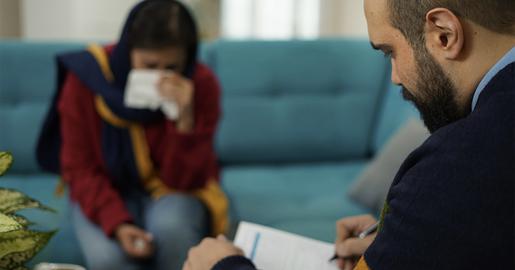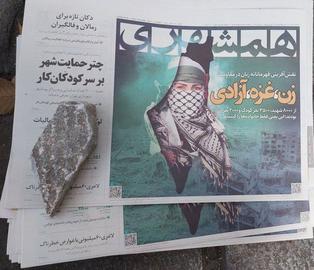On October 19, quoting Ali Fathi Ashtiani, president of Iran’s Psychology and Counselling Organization, Shargh newspaper announced new rates for the services of psychologists and counselors as recommended by President Ebrahim Raisi’s cabinet. Forty-five minutes of counseling with a masters-level professional should cost 230,000 tomans ($4,47) while doctorate-level therapists should charge 270,000 tomans ($5.24).
Ashtiani asked psychologists and counsellors to abide by these rates – even as he pointed out that they cannot cover the costs of any therapists operating clinics or counselling centers.
The problem, as revealed through a series of IranWire interviews with both mental health patients and healthcare professionals, is that seeking counselling may be unaffordable for many Iranians even as the official rates for such services are unworkable for providers. Several people also told IranWire that, rather than paying for higher-cost psychologists to receive regular therapy, they can only afford occasional to see a psychiatrist and to take medication for mental health problems.
Unaffordable: the view among patients
A few Iranians try to combine basic counselling with psychiatric treatment. “Besides prescribing medicine, the psychiatrist whom I visit also gives me counseling,” says Reza, 35, a teacher who lives in Tehran. “I always have an eye on the clock, so that I will not continue the session after 20 minutes, because the secretary counts the rate second by second. The last time, I paid around 200,000 tomans ($3.90) for a session that lasted about 15 minutes.”
Reza says he has continued receiving therapy and counseling sessions but only once every three months, for the past six years, and has paid for them regardless of the cost.
“The first time I went to a psychologist was after I had serious thoughts of suicide and suffered from a lot of stress, as a result of issues related to my work and my schooling,” Reza tells IranWire. “The doctor's diagnosis was depression, obsession, and ADHD [attention-deficit/hyperactivity disorder]. During this time, I have been prescribed three to four pills a day, which I take in the morning, at noon and at night. My doctor has recommended that it is better to see a therapist at regular intervals, but the cost is too high for me, because I have to dedicate several sessions to introducing myself and my condition and everything that has led me to this situation, and then there are no guarantees that the counselor can help me or will turn out to be the right one [for my needs].”
Reza has a good education from a prestigious university and, before last year’s nationwide protests, he earned enough to support his lifestyle and needs. But when he supported the protests he lost his job and now he juggles a series of less stable jobs.
"Given my unstable economic situation, I know that it is impossible for me to maintain an orderly therapy schedule, making each session less and less significant,” Reza says. “That's why I haven't dared to go to a therapist. I know some good therapists among my friends and family but, because we are close to each other, they cannot be my therapists professionally."
When asked how much he pays for his medication every month, Reza says: "I spend about 200,000 tomans ($3.90) a month for medicine, although the prescriptions for me are usually written for three months, so that I have enough until my next visit. I buy it all at once. Some drugs become hard to find. For example, fluoxetine [to treat depression and obsessive-compulsive disorder] couldn’t be found at one point so the doctor changed it to sertraline. ADHD drugs are always difficult to find. For several years now, Ritalin, which is from abroad, has not been available through official channels and smugglers sell it with a high markup. A few blister packs of Ritalin might be fix or six million tomans a month which is more than I can afford.”
“If there comes a time when I can spend a few million tomans a month, on therapy, it will mean that my psychological condition had improved so much that I can take care of my life. Right now, I believe that most of my mental crises are rooted in my financial problems,” Reza adds.
Maryam, 25, lives in a small city in Yazd province. She has stopped receiving therapy, she says, and the last time she had a session was in March.
“I paid 600,000 tomans [$11.70] for each one-hour therapy session,” Maryam tells IranWire. “At this point, I only regularly visit my psychiatrist [and not the psychologist] but the visits are far apart. Visiting the psychologist costs around 600,000 tomans for a 15-20 session. Medication also cost me 200,000 tomans [$3.90] a month.”
Maryam says that, when she used to visit her therapist every week for two years, the cost became too high. “I paid 800,000 tomans [$15.50] for four one-hour sessions. Even then, this was a high price for me and financial issues were the major reason that forced me to stop therapy,” she says.
Saber, 45, lives in a small town in southern Iran. He says that therapy has never been a priority in his life due to its high cost and his own doubts in its value or effectiveness.
"I have tried therapy several times, but I did not have enough money, even to pay for the last sessions. I must limit myself to seeing a psychiatrist and taking pills. But these days, I can’t afford even this, as these visits and medications have become expensive, and it is very difficult when you have no insurance and are unemployed. I am always preoccupied and afraid of not having enough medicine, and many other things, especially when several types of medications are necessary. Going to a therapist in this situation wouldn’t help.”
Considering that Saber lives in a small town: is it difficult to find all the medications he needs?
“In small towns, brand name medications such as Ritalin are rationed and, sometimes, they are not available, so doctors have to prescribe replacements and replacement medications usually have side effects,” Saber says.
Ziba is a 33-year-old woman in Tehran. She says she used to attend weekly therapy since early 2019: “I was a very agitated person, but the main spark for starting therapy was that I went into psychology myself. But I should have started sooner because the goal was to be treated. My sessions last from 45 minutes to an hour and the cost is about 400,000 tomans ($7.80] per session.”
Nazanin, who lives in Shiraz, says that “psychological problems cannot be solved in one session and they need many sessions”. She tells IranWire: “I am under so much psychological pressure that my mental wounds have turned into physical pains. However, the economic situation is such that it is not possible to continuously get help from therapy. Besides, since the sources of pressure in our country are permanent, going to a therapist is like taking painkillers.”
Nazanin tells IranWire that, to pay for the sessions, she has spent less on clothes and other quality of life items, so that she can get help from a therapist when necessary.
"I have paid up to 800,000 tomans [$15.5] for one session. Earlier, when the economic situation was not like this, I could set aside part of my income for this at the beginning of every month, but now it is not really possible," she says.
Nika lives in Shahin Shahr in Isfahan. Both she and her husband attend online therapy sessions: “My husband and I each pay 650,000 tomans [$12.60] per month for these one-hour therapy sessions. It is difficult financially, but we have no choice. Sometimes we also go to group therapy, the cost of which is more reasonable, but it is not always possible."
Unworkable: the view among providers
Ali Fathi Ashtiani, head of Iran’s Psychology and Counselling Organization, admitted when he announced the new prescribed cousnelling rates that the prices were too low to cover the costs incurred by counselors and psychologists. But he said that, all the same, if any patients filed a complained against a healthcare provider for charging more than the established rates then a commission of experts and lawyers would be formed to investigate the matter.
A psychologist in Iran tells IranWire that the "the rates declared [by the government] only applies to those who are registered with the Psychology and Counselling Organization, but not to individuals who work under the supervision the Welfare Organization or other places. Over the years, psychologists and psychology experts have always been unhappy with government-approved rates because they have no relation to the cost of living and other economic conditions.”
The psychologist points out that, currently, even the rate of counseling by phone in Iran is at least 300,000 tomans [$5.80].
"The approved rates are absolutely not fair and will only lead to a drop in therapy services provided by specialists, because the therapists have to forgo some of tests or therapeutic techniques to comply with the approved rate,” the psychologist says.
The psychologist adds that the rates set by the government create a license for corruption among therapy providers.
“We have to continuously participate in various analytical and psychoanalytical courses, which cost a lot. For example, I paid 8 million tomans [$155.40] to take a course. We must buy books and other tools. We must receive therapy just to survive giving therapy. The expenses of being a therapist are high. How can we maintain the quality of therapy high with such low rates?”
A child psychologist in Iranian Kurdistan, meanwhile, tells IranWire that, “In the two clinics where I work, they charge 450,000 tomans [$8.74] for each therapy session. Therapy costs for children are higher than for adults. I know it is difficult for many families to pay the cost, but I believe it is more of an investment than an expense, because if psychological problems or traumas are not treated during childhood then they become more problematic and expensive as an adult.”
“The rates for therapy must be set by considering a psychologist’s education level, special courses they have taken, where the patient and therapist are based, the provider’s experience and reputation, and the duration of the therapy session,” the child psychologist adds.
“Moreover, the Psychology and Counselling Organization can set such meagre rates for therapy sessions only if the organization itself trains psychologists at a low cost, whereas courses offered by this organization, for instance in child psychology, which is my field of expertise, cost twice as much as similar courses offered by other organizations.”
visit the accountability section
In this section of Iran Wire, you can contact the officials and launch your campaign for various problems

























comments